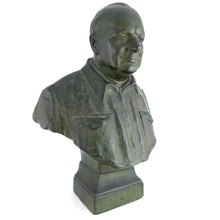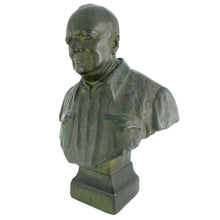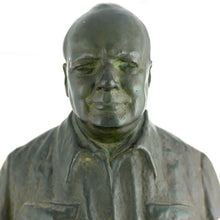Second World War Portrait Bust of Churchill, 1945
Adding product to your cart
Height: 31.5cm (12.3in)
Patinated electrotype portrait bust of Prime Minister Winston Churchill. Signed ‘Albert Toft ’ to the rear of the left shoulder.
Toft’s portrait shows the wartime leader attired in his famous ‘Siren’ suit and wearing a knowing expression of quiet determination. The process used to produce Toft’s portrait bust is electrotyping or ‘electroforming’, which was first developed in the early nineteenth century as an economical way to manufacture large-scale objects, that otherwise would be cast in bronze.
Second World War regulations on non-essential industrial output and a paucity of raw materials determined Toft’s use of electrotyping. This method involved immersing a negative mould or a positive wax model into a plating tank and letting copper adhere itself by electro-deposition onto the surface of the immersed objects, until one or other had built up to a structural thickness.
Read more
Albert Toft (1862-1949) was an exponent of the New Sculpture movement. He was the son of the designer and pottery modeller Charles Toft. He studied at Birmingham, and then at Hanley and Newcastle under Lyme Schools of Art. During this time he was also apprenticed to Wedgwood as a modeller. In 1879 he won a National Scholarship to the National Art Training Schools (now the Royal College of Art), London, where he studied for two years under Edouard Lanteri.
Throughout his career he produced portrait busts of the great and the good. After the turn of the century, Toft took up commemorative public sculpture, with figures of Queen Victoria for Leamington (1902) and Nottingham (1905), several Boer War Memorials, including those in Birmingham (1905) and the Welsh National Memorial in Cardiff (1909), and, after the First World War, many more war memorials, notably the Royal Fusiliers (City of London Regiment) Memorial at Holborn, an exact copy of which stands as the 41st Division Memorial at Flers in France. He sculpted the Chadderton War Memorial (1921) in Oldham and the Monument to Captain Albert Ball, VC in the grounds of Nottingham Castle.
In the 1923-24 he sculpted the seated bronze allegorical figures representing the Navy, Army, Air Force and Women’s Services as an integral part of the design of the Hall of Memory in Centenary Square, Birmingham. Socially gregarious, Toft was a stalwart of the Savage Club, figuring prominently in their affairs, frequently presiding over their House Dinners. He was elected to the Art Workers Guild in 1891 and his sculptor’s manual ‘Modelling and Sculpture’ was published in 1911. He exhibited at the Royal Academy between 1885 and 1947, and was elected a Fellow of the Royal Society of British Sculptors in 1938.












